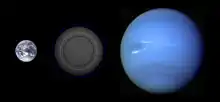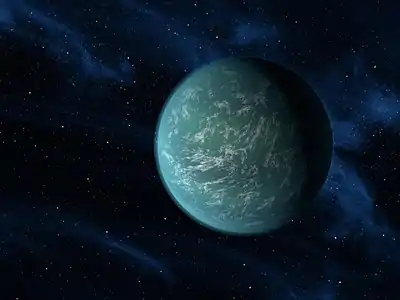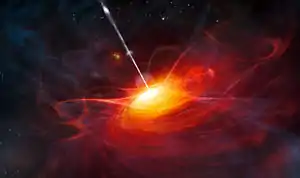Gliese 581d
Gliese 581d /ˈɡliːzə/ (often shortened to Gl 581d or GJ 581d) is an extrasolar planet orbiting within the Gliese 581 system, approximately 20.4 light-years away in the Libra constellation. It is the third planet claimed in the system and (assuming a five-planet model) the fifth in order from the star.
 Size comparison of Gliese 581d with Earth and Neptune.
(Based on selected hypothetical modeled compositions) | |
| Discovery | |
|---|---|
| Discovered by | Udry et al.[1] |
| Discovery site | La Silla Observatory, Chile |
| Discovery date | 24 April 2007[1] |
| Radial velocity | |
| Orbital characteristics | |
| Epoch JD 2451409.762[2] | |
| 0.21847 ± 0.00028 AU (32,683,000 ± 42,000 km)[2] | |
| Eccentricity | 0[2] |
| 66.87 ± 0.13[2] d 0.183 y 1600 h | |
| 56 ± 27[2] | |
| Semi-amplitude | 1.91 ± 0.22[2] |
| Star | Gliese 581[2] |
| Physical characteristics | |
Mean radius | 2.20 [3] R⊕ |
| Mass | 6.98[3] M⊕ |
Though not confirmed to be a terrestrial planet and significantly more massive than Earth (at 6.98 Earth masses), the Super-Earth is the first exoplanet of terrestrial mass proposed to orbit within the habitable zone of its parent star.
Assuming its existence, computer climate simulations have confirmed the possibility of the existence of surface water and these factors combine to a relatively high measure of planetary habitability.
Discovery
A team of astronomers led by Stéphane Udry of the Geneva Observatory used the HARPS instrument on the European Southern Observatory 3.6 meter telescope in La Silla, Chile, to discover the planet in 2007. Udry's team employed the radial velocity technique, in which the mass of a planet is determined based on the small perturbations it induces in its parent star's orbit via gravity.[4]
Disputed existence
In September 2012, Roman Baluev filtered out the "red noise" from the Keck data and concluded that this planet's existence is probable only to 2.2 standard deviations.[5] That same year, however, a team from the USNO confirmed the existence of the planet with a much higher probability; they also pursued a dynamical analysis of the system.[6]
A study in 2014 concluded that Gliese 581d is "an artifact of stellar activity which, when incompletely corrected, causes the false detection of planet g."[7][8][9] In 2015, a study by Guillem Anglada-Escudé and Mikko Tuomi discounted the 2014 work and conveyed reasoning based on their own statistical analysis in favor of the planet's existence.[10][11][12]
In a related matter, Newton et al. (2016) pointed out that for early M dwarfs, planets in their habitable zones may have orbital periods coinciding with the stellar rotation period (or in rare cases, such as Gliese 581d, multiples of it); this aspect seriously affects the efforts of verification for any of those planets.[13] Hence, this type of number relation does not constitute a valid counterargument against the reality of such a planet, which tends to strengthen the case for the existence of Gliese 581d.
If the planet’s confirmation continues to hold, Gliese 581d will constitute the first planet identified to be located in a stellar habitable zone outside of the Solar System,[14][15] based on studies of 2007.
Orbital characteristics
Gliese 581d orbits Gliese 581 at 0.21847 AU, approximately a fifth of the distance that the Earth orbits the Sun, though its orbital eccentricity has not been confirmed. There are currently two models for its orbit, a circular one like Earth's, and an eccentric one like Mercury's. These are based on the four planet and six planet model for the Gliese 581 system, respectively. Under the four planet model Gliese 581d would most probably be in a spin-orbit resonance of 2:1, rotating twice for each orbit of its parent star. Therefore, the day on Gliese 581d should approximately be 67 Earth days long.[6][16]
The orbital distance places it at the outer limits of the habitable zone, the distance at which it is believed possible for water to exist on the surface of a planetary body. At the time of its discovery, the planet's orbit was originally thought to be farther out. However, in late April 2009 the original discovery team revised its original estimate of the planet's orbital parameters, finding that it orbits closer to its star than originally determined with an orbital period of 66.87 days. They concluded that the planet is within the habitable zone where liquid water could exist,[17][18] thus confirming previous studies. Moreover, the data[19] also suggested that the proposed exoplanet[20] could have at least one[21] or more large oceans.
Physical characteristics
The motion of the parent star indicates a minimum mass for Gliese 581d of 5.6 Earth masses (earlier analyses gave higher values).[2] Dynamical simulations of the Gliese 581 system assuming that the orbits of the three planets are coplanar show that the system becomes unstable if the masses of the planets exceed 1.6–2 times the minimum values. Using earlier minimum mass values for Gliese 581d, this implies an upper mass limit for Gliese 581d of 13.8 Earth masses.[17] The composition of the planet, however, is not known.
Climate and habitability

As the planet is not known to transit from Earth and atmospheric conditions are not observable with current technology, no atmosphere for the planet has been confirmed to date. As such, all climate predictions for the planet are based on predicted orbits and computer modelling of theoretical atmospheric conditions.
Because Gliese 581d was believed to orbit outside the habitable zone of its star it was originally thought to be too cold for liquid water to be present. With the 2009 revised orbit, climate simulations conducted by researchers in France in 2011 indicated possible temperatures suitable for surface water at sufficient atmospheric pressure.[22] According to Stéphane Udry, "It could be covered by a 'large and deep ocean'; it is the first serious ocean planet candidate."[23]
On average, the light that Gliese 581d receives from its star has about 30% of the intensity of light the Earth receives from the Sun. By comparison, sunlight on Mars has about 40% of the intensity of that on Earth.[22] That might seem to suggest that Gliese 581d is too cold to support liquid water and hence is inhospitable to life. However, an atmospheric greenhouse effect can significantly raise planetary temperatures. For example, Earth's own mean temperature would be about −18 °C[24] without any greenhouse gases, ranging from around 100 °C on the day side to −150 °C at night, much like that found on the Moon. If the atmosphere of Gliese 581d produces a sufficiently large greenhouse effect, and the planet's geophysics stabilize the CO2 levels (as Earth's does via plate tectonics), then the surface temperature might permit a liquid water cycle, conceivably allowing the planet to support life.[25][26][27][28] Calculations by Barnes et al. suggest, however, that tidal heating is too low to keep plate tectonics active on the planet, unless radiogenic heating is somewhat higher than expected.[29]
Gliese 581d is probably too massive to be made only of rocky material. It may have originally formed on a more distant orbit as an icy planet that then migrated closer to its star.[14][30]
Hello from Earth
As part of the 2009 National Science Week celebrations in Australia, Cosmos magazine launched a website called "Hello from Earth" to collect messages for transmission to Gliese 581d. The maximum length of the messages was 160 characters, and they were restricted to the English language. In total, 25,880 messages were collected from 195 countries around the world. The messages were transmitted from the DSS-43 70 m radio telescope at the Canberra Deep Space Communication Complex at Tidbinbilla, Australia, on 28 August 2009.[31]
In popular culture
Gliese 581d is the setting for the Doctor Who episode "Smile".[32] It is also shown in Into the Universe with Stephen Hawking's Episode 3: The Story of Everything.
See also
References
- Udry; et al. (2007). "The HARPS search for southern extra-solar planets, XI. Super-Earths (5 and 8 M⊕) in a 3-planet system". Astronomy and Astrophysics. 469 (3): L43–L47. arXiv:0704.3841. Bibcode:2007A&A...469L..43U. doi:10.1051/0004-6361:20077612.
- Vogt, S. S.; et al. (2010). "The Lick-Carnegie Exoplanet Survey: A 3.1 M⊕ Planet in the Habitable Zone of the Nearby M3V Star Gliese 581". The Astrophysical Journal. 723 (1): 954–965. arXiv:1009.5733. Bibcode:2010ApJ...723..954V. doi:10.1088/0004-637X/723/1/954.
- "PHL's Exoplanets Catalog - Planetary Habitability Laboratory @ UPR Arecibo". Planetary Habitability Laboratory.
- "The HARPS search for southern extra-solar planets" Archived 2010-10-08 at the Wayback Machine, S. Udry. X. Bonfils. X. Delfosse. T. Forveille. M. Mayor. C. Perrier. F. Bouchy. C. Lovis. F. Pepe. D. Queloz. J.-L. Bertaux. The Extrasolar Planets Encyclopaedia. April 4, 2007. Accessed June 10, 2011
- Roman Baluev (2012). "The impact of red noise in radial velocity planet searches: Only three planets orbiting GJ581?". Monthly Notices of the Royal Astronomical Society. 429 (3): 2052–2068. arXiv:1209.3154. Bibcode:2013MNRAS.429.2052B. doi:10.1093/mnras/sts476.
- Makarov, Valeri V.; et al. (2012). "Dynamical evolution and spin-orbit resonances of potentially habitable exoplanets. The case of GJ 581d". The Astrophysical Journal. 761 (2): 83. arXiv:1208.0814. Bibcode:2012ApJ...761...83M. doi:10.1088/0004-637X/761/2/83.
- Robertson, Paul; Mahadevan, Suvrath; Endl, Michael; Roy, Arpita (3 July 2014). "Stellar activity masquerading as planets in the habitable zone of the M dwarf Gliese 581". Science. 345 (6195): 440–444. arXiv:1407.1049. Bibcode:2014Sci...345..440R. CiteSeerX 10.1.1.767.2071. doi:10.1126/science.1253253. PMID 24993348.
- Quenqua, Douglas (7 July 2014). "Earthlike Planets May Be Merely an Illusion". New York Times. Retrieved 8 July 2014.
- "New doubt cast on 2 of the most Earth-like planets ever found". CBC News. Retrieved January 7, 2017.
- Anglada-Escudé, Guillem; Tuomi, Mikko (6 March 2015). "Comment on "Stellar activity masquerading as planets in the habitable zone of the M dwarf Gliese 581"". Science. 347 (6226): 1080–b. arXiv:1503.01976. Bibcode:2015Sci...347.1080A. doi:10.1126/science.1260796. PMID 25745156.
- "Reanalysis of data suggests 'habitable' planet GJ 581d really could exist". Astronomy Now. 9 March 2015. Retrieved 27 May 2015.
- https://www.inquisitr.com/1906009/gliese-581d-new-study-confirms-existence-of-one-of-most-earth-like-extrasolar-planets-known/
- Newton, Elisabeth R.; Irwin, Jonathan; Charbonneau, David; Berta-Thompson, Zachory K.; Dittmann, Jason A. (2016). "The Impact of Stellar Rotation on the Detectability of Habitable Planets around M Dwarfs". Astrophysical Journal Letters. 821 (1): L 19 (6 pp.). arXiv:1604.03135. Bibcode:2016ApJ...821L..19N. doi:10.3847/2041-8205/821/1/L19.
- von Bloh, W.; Bounama, C.; Cuntz, M.; Franck, S. (2007). "The Habitability of Super-Earths in Gliese 581". Astronomy & Astrophysics. 476 (3): 1365–1371. arXiv:0705.3758. Bibcode:2007A&A...476.1365V. doi:10.1051/0004-6361:20077939.
- Selsis, F.; Kasting, J. F.; Levrard, B.; Paillet, J.; Ribas, I.; Delfosse, X. (2007). "Habitable planets around the star Gliese 581?". Astronomy & Astrophysics. 476 (3): 1373–1387. arXiv:0710.5294. Bibcode:2007A&A...476.1373S. doi:10.1051/0004-6361:20078091.
- Heller, René; Barnes, Rory; Leconte, Jérémy. (August 2011). "Habitability of extrasolar planets and tidal spin evolution". Origins of Life and Evolution of Biospheres. Onlinefirst (6): 539–543. arXiv:1108.4347. Bibcode:2011OLEB...41..539H. doi:10.1007/s11084-011-9252-3. PMID 22139513.
- M. Mayor; X. Bonfils; T. Forveille; X. Delfosse; S. Udry; J.-L. Bertaux; H. Beust; F. Bouchy; C. Lovis; F. Pepe; C. Perrier; D. Queloz; N. C. Santos (2009). "The HARPS search for southern extra-solar planets,XVIII. An Earth-mass planet in the GJ 581 planetary system". Astronomy & Astrophysics. 507 (1): 487–494. arXiv:0906.2780. Bibcode:2009A&A...507..487M. doi:10.1051/0004-6361/200912172.
- "Lightest exoplanet yet discovered". eso.org. 2009-04-21. Archived from the original on 2009-07-05. Retrieved 2009-04-21.
- R. Stewart, (2013). " First View of Gliese-581 d; A preliminary Surface Survey (Part-1). Publisher-(IJAAR), (Issue 2013). At-http://www.journals-of-science.com/5-feature-research-pap.html
- STEWART, R., CELEBONOVIC, V., AGUIAR, O.A.,CHATZITHEODORIDIS, E., ACKERMAN, J., ROMAN, M.,ARTUSO, G., TRENTADUE, W., SAMADI, A., ARISTIZABAL,C.I.O. and others. Gliese 581d; Views of Its atmospheric, topographical, geological, and oceanic conditions (Part 2). Journal of The International Society of Peer Reviewers. Available at: "Archived copy". Archived from the original on 2013-08-30. Retrieved 2013-09-01.CS1 maint: archived copy as title (link) . Which in summary shows its atmosphere geology topography and oceanic conditions.
- AGUIAR, O.A., STEWART, R., ARTUSO, G., SAMADI, A., ARISTIZABAL, C.I.O., ACKERMAN, J.R., TRENTADUE, W. The (possible) confirmation of the First exo-oceans. Pluralidade 1: 82–95, 2013. At- http://www.pluralidade.info/Eindex.html .
- Wordsworth, R.; et al. (2011). "Gliese 581d is the first discovered terrestrial-mass exoplanet in the habitable zone". The Astrophysical Journal. 733 (2): L48. arXiv:1105.1031. Bibcode:2011ApJ...733L..48W. doi:10.1088/2041-8205/733/2/L48.
- "Lightest exoplanet yet discovered", European Southern Observatory. April 21, 2009. Accessed June 10, 2011
- "Global Warming Frequently Asked Questions". Lwf.ncdc.noaa.gov. 2008-05-08. Archived from the original on 2009-01-19. Retrieved 2009-01-18.
- von Bloh, W.; et al. (2008). "Habitability of Super-Earths: Gliese 581c and 581d". Proceedings of the International Astronomical Union. 3: 503–506. arXiv:0712.3219. doi:10.1017/S1743921308017031.
- "Centauri Dreams » Blog Archive » Gliese 581d: A Habitable World After All?". Centauri-dreams.org. 2007-12-13. Retrieved 2009-01-18.
- "New 'Super Earth 2' Discovered in Constellation Libra". Dailygalaxy.com. 2007-06-15. Retrieved 2009-01-18.
- Wordsworth, Robin; François Forget; Franck Selsis; Ehouarn Millour; Benjamin Charnay; Jean-Baptiste Madeleine (2011). "Gliese 581d is the first discovered terrestrial-mass exoplanet in the habitable zone". The Astrophysical Journal. 733 (2): L48. arXiv:1105.1031. Bibcode:2011ApJ...733L..48W. doi:10.1088/2041-8205/733/2/L48.
- Barnes, Rory; Jackson, Brian; Greenberg, Richard; Raymond, Sean N. (2009-06-09). "Tidal Limits to Planetary Habitability". The Astrophysical Journal. 700 (1): L30–L33. arXiv:0906.1785. Bibcode:2009ApJ...700L..30B. doi:10.1088/0004-637X/700/1/L30.
- "Hopes Dashed for Life on Distant Planet". Space.com.
- Jenkins, Simon (2009-08-28). "Earth sends 25,000 hellos to outer space". Brisbane Times. Retrieved 2009-09-16.
- "Visit Doctor Who's spectacular colony world... In Valencia".
External links
| Wikinews has related news: |
| Wikimedia Commons has media related to Gliese 581 d. |
- National Science Week 2009 - Send A Message To Gliese 581d
- Wordsworth, R. D.; et al. (2010). "Is Gliese 581d habitable? Some constraints from radiative-convective climate modeling". Astronomy & Astrophysics. 522: A22. arXiv:1005.5098. Bibcode:2010A&A...522A..22W. doi:10.1051/0004-6361/201015053.
| Preceded by None |
Highest ESI for an Exoplanet 2007–2010 |
Succeeded by Gliese 581g |


.jpg.webp)
